Positive Health Online
Your Country

Meditations To Boost Back Health
listed in back pain, originally published in issue 279 - June 2022
Introduction
Back pain, neck pain, sciatica and arm pain are the most common complaints around the globe. In all countries, 4 out of 5 people suffer from these ailments at some point in their life. The cumulative world cost for treating these pains is $300 - $500 billion dollars per year. The pandemic has rendered people to solitary states & has diminished our mobility and worsened our back pain. If you have ever had these pains, you know how hard it is to focus on anything else… you search for all the answers and remedies, just to feel normal again. Well, here is the answer you’ve been looking for.
As a known and published spinal surgeon, Dr Ken Hansraj has dedicated more than 20 years of his life to helping people across the globe improve their spinal health. He is a prominent proponent of whole-body wellness, preventative care, and treating the spine as the ‘principal indicator’ of general health, impacted by ‘human software and hardware’. As part of his holistic approach, Dr Ken has been meditating daily for years to treat his own chronic pain. After realizing the profound positive effects of meditating, Dr Ken was inspired to create his own meditation program, LIFT: Meditations to Boost Back Health, which applies his spinal health knowledge and expertise into a six-track CD.
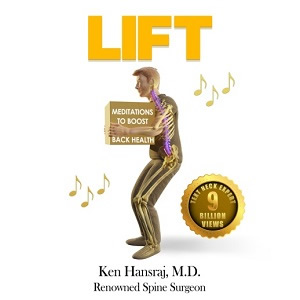
I am Dr Ken Hansraj, one of the world's most experienced spine surgeons, and I’ve been meditating daily for years to treat my own pains with amazing effect. In this program, I am going to give you those very same meditations which have drastically benefited my health and the health of my clients & loved ones. These meditations will diminish back pain, restore mobility & strength, improve your posture, and make you more productive.
History: Resources to Educate about the Spine
Hansraj KK: Assessment of Stresses in the Cervical Spine Caused by Posture and Position of the Head. Surgical Technology Int. 2014 Nov; 25:277–9.
Hansraj KK; Hansraj J.A.; Griffin-Hansraj, M.D.; Kiernan, J.; Subesan, N., Firtat, B.; Elsisi, A. Backpack Forces on the Spine. Surgical Technology Int. 2018 Nov; 33:361 – 365
Hansraj KK: Breast Forces on the Spine.
Surgical Technology Int. 2016 Apr; 28:311–5
Belly Fat Forces on the Spine: March 30, 2022
Hansraj KK: Abdominal Forces on the Spine. In Press. Surgical Technology Int. 2022 Mar; 40:XX-XX
Lift Forces on the Spine: In Press
Here Comes an Effort to Help People, Globally, with Back and Neck Pain
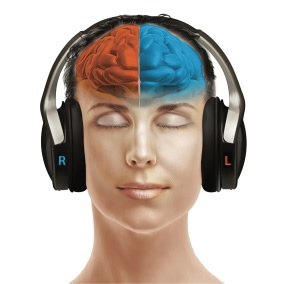
“Posture Forces on the Spine” is a neuro-linguistic programming (NLP) meditation – (right ear, center channel and left ear) meant to help bring awareness to your posture, especially to the everyday postural forces, such as text neck, belly fat, breast weight, lifting, and backpack forces. Dr Ken describes the problem in the center channel, an authoritative male voice gives the mathematical break-down in the right ear, and a healing feminine voice tells you strategies on how to protect your back in the left ear. The beautiful supporting music is provided by world-renowned professors of music from the Juilliard School of Music.
For: *people on cell phones and smart devices, *obese people *tall people *women with large breasts *everyday person, *construction workers, *supermarket employees, *stock replacement employees *express delivery person, *water carriers *military *students with backpacks.
This meditation explores the back-saving strategies of posture on a phone, belly fat impact to back pain, breast forces to the spine by breast size, magnified spine forces seen in a backpack in kids and the military, and how lifting sends stresses to the spine.
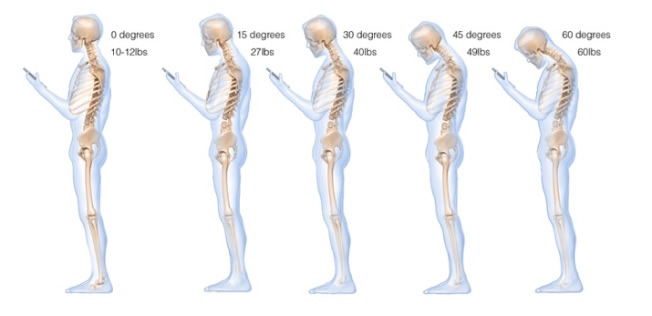
Text Neck Forces On The Spine
Dr Ken Hansraj (Center Channel)
The world population is 7.5 billion, spine care costs between $300 to $500 billion dollars per year.By 2100 with 11 billion people, spine care costs will be 1 trillion dollars per year. 4/5 Persons do have or will have significant back or neck pain at some point in their lives.
We performed a finite mathematical study to assess the stresses about the neck when the head incrementally moves forward. Billions of people are using smartphones and electronic devices throughout the world, ritualizing poor posture.
People spend an average of two to four hours a day with their heads tilted over reading, and texting on their smartphones and devices.
Cumulatively, this amounts to 700 to 1,400 hours a year of excess stresses experienced by the neck.
Dr Gregory Knowles (Right Ear Channel)
An adult head weighs 10-12 pounds in the neutral position. As the head tilts forward, the forces seen by the neck surge to 27 pounds at 15 degrees, the head exerts 40 pounds of force at 30 degrees, and 50 pounds of force at 45 degrees, the head exerts 60 pounds of force at 60 degrees.
Dr Marcia Griffin-Hansraj (Left Ear Channel)
When you’re on your smart device, just keep your head up!!
Look down with your eyes and raise the device up a bit!!
Remember good posture is the most efficient and least stressful position for the spine.
When people become aware and awake, then they stay in good posture.
Always, always watch where your head is in space.
Music track by Professor Kendall Durelle Briggs.
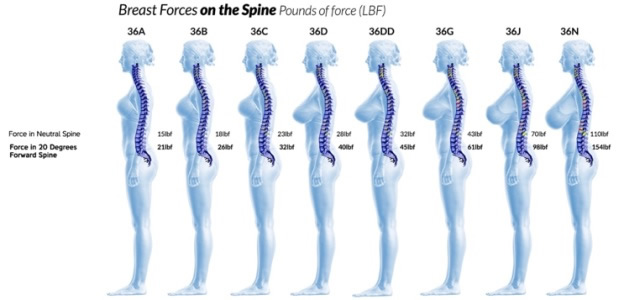
Breast Forces on The Spine
Women have complained about the pain caused by breast weight since the dawn of humanity. Large breasts have been the source of physical complaints of back pain and neck pain. With a 36D bust, after 10 years, with five hours a day unsupported by a bra, a woman’s spine could see 500,000 pounds of additional force.
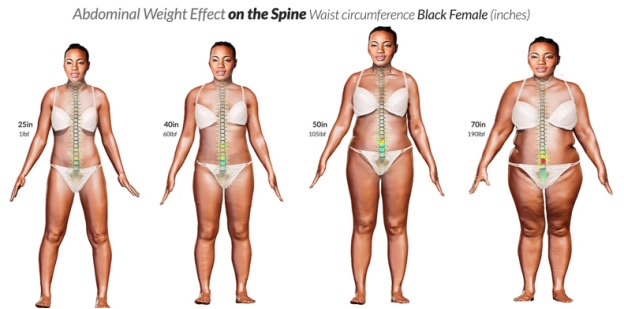
Belly Fat Forces On The Spine
People everywhere are suffering as a result of large bellies. Big bellies are associated with diabetes, heart conditions, metabolic disorders and back pain. A white female with a 50-inch waist circumference can experience 88 pounds of force to the lumbar spine—for a black female it’s 105 and for a Hispanic female it’s 59 on average. This force is equivalent to the weight of up to nine 12-pound bowling balls. A white male with a 50-inch waist circumference can experience 65 pounds of force added to the lumbar spine, for a black man it’s 74 and for a Hispanic man 59. This force is equivalent to up to six12-pound bowling balls.
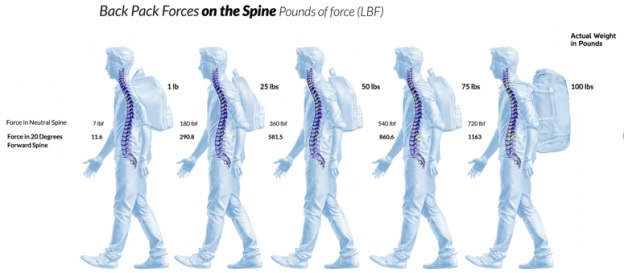
Backpack Forces on The Spine
Backpacks are standard load carriers for people of all ages, especially those of school age, athletes and members of the military. A military officer carrying 100 pounds in his/her backpack experiences 720 pounds of force in a neutral spine. But when the officer leans forward 20 degrees, then the force becomes 1,163 pounds of force. In 10 years, with just one hour a day of backpack use for 250 days a year, the spine could experience 3 million pounds of additional force.
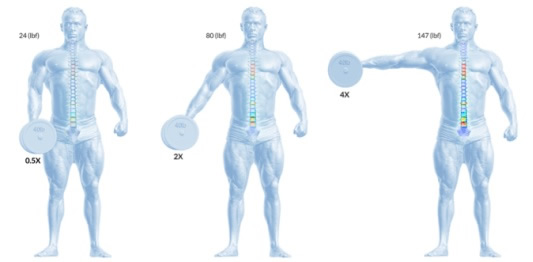
Lifting Forces on The Spine
Physicians, physical therapists and health advisors intuitively recommend that people carry objects close to their bodies. When the arm is close to the body, then the forces are 0.5 times the weight. When the arm is raised 45 degrees, then the forces are two times the weight. When the arm is raised 90 degrees, then the forces are four times the weight. An everyday person can lift cumulatively 20 to 50 pounds a day, which leads to seven to 18,000 pounds of force per year. Some jobs, such as express delivery workers, water deliverers, and construction workers routinely lift 5,000 pounds a day. We have worked with express delivery workers who handle 1 to 1.5 million pounds of lifting a year to determine the best spine solutions.
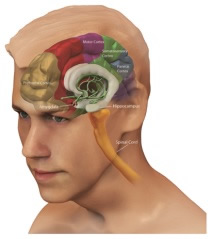
About Meditation
Many people, even physicians, believe that the brain and spine are separate, even though the spinal cord and nerve roots bring and carry information to the brain. Hundreds of recent studies with functional MRI scans show that with meditation, the physical structure of the brain changes in a positive way called positive neuroplasticity. The frontal thinking cortex becomes thicker, and the reactive, reptilian emotional brain becomes smaller. The corpus callosum which connects the right and left brain, becomes thicker. Long-term studies show meditation results in more volume, a better geometry of the brain, and a slowing of the epigenetic clock, meaning a longer life and fewer chronic diseases. Studies have also shown that meditation increases the size of telomeres – the caps at the end of chromosomes that protect DNA from deterioration.
Traditional meditation involves sitting in a quiet, calm and peaceful place. My mother taught me to keep my spine straight and to breathe in and out with conviction as I sat in a cross-legged sitting posture, known as the lotus position, that originated in meditative practices of ancient India. More profound meditation, such as alternate nostril breathing, includes breathing through one nostril at a time and out through the opposite. Yogis believe that this exercise can cleanse and rejuvenate your energy channels. As you sit, thoughts, emotions, and feelings will come to you. It’s important to recognize them and allow them to pass without letting yourself become attached. The thoughts and emotions diminish with time, which provides access to universal thoughts and energies. This process is excellent for resetting our minds from the frustrations and negativity called negative neuroplasticity that prevents us from achieving our daily regimens that keep us healthy and pain-free.
Guided imagery is the process of sitting in a quiet, comfortable place while relaxing and following audio or video instructions. An instructor guides you through various scenarios of directed thoughts and suggestions that lead your imagination toward a relaxed, focused state to help cleanse physical and emotional burdens.
Further Information
LIFT – Meditations to Boost Back Health – Apple Music
Lift – Meditations to Boost Back Health – Amazon Music
Ken Hansraj, MD
Produced by Greg Knowles and James Fallon
Engineer Joe Costable
Mixed and Mastered by Joe Costable, James Fallon and Greg Knowles
Recorded at Concert D Studios, Armonk, NY
Photos Jeff Karg and Prakash Mehta
Cover Design Prakash Mehta
Public Relations Richard Rubenstein
Comments:
-
No Article Comments available